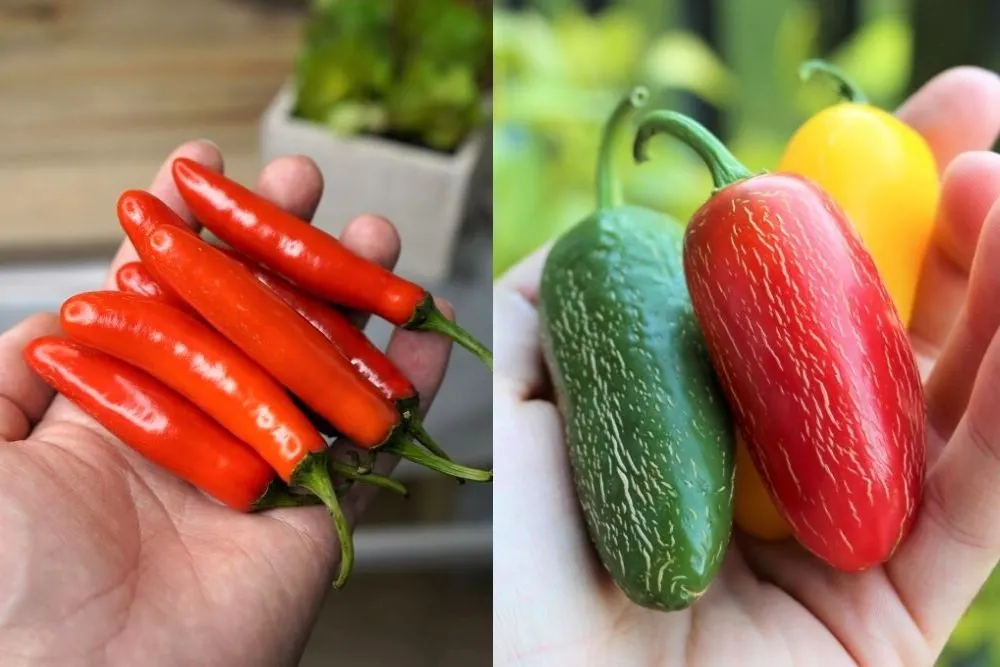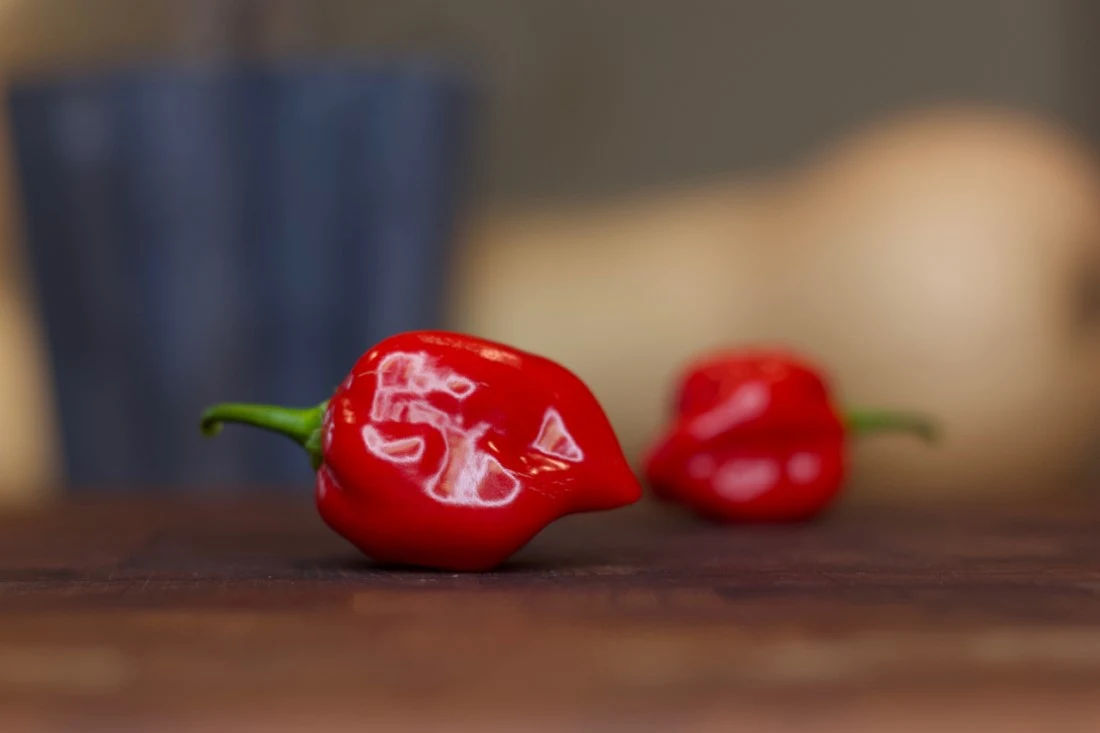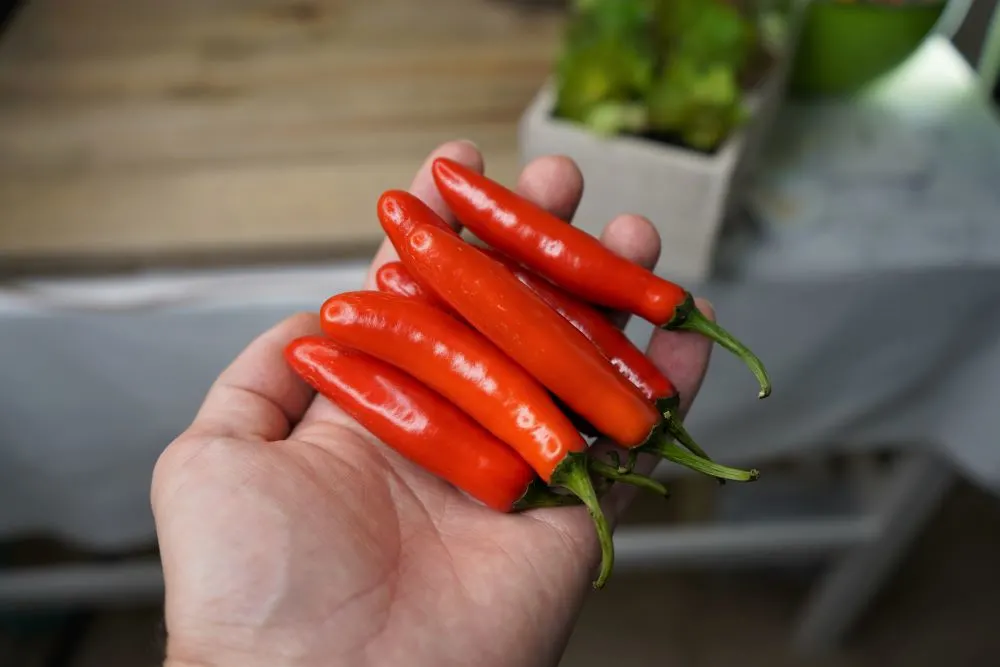This article’s purpose is to clear up any and all confusion between serrano and jalapeño peppers. There are several commonly asked questions regarding the two pepper varieties.
Which pepper is hotter? Which species does each come from? Can you make serrano poppers? We’ll cover all of this and more so you know which variety to choose at the supermarket.

Serrano vs Jalapeno Peppers
There are several major differences between serranos and jalapenos, but there are many commonalities as well. Here, we’ll cover the basic categories and compare the two pepper varieties.
Size
One of the most obvious differences is size. Serranos are similar in length to jalapenos, but they are significantly slimmer. This makes them less appealing for stuffed peppers (poppers), and more useful for chopped salsas or stir fry.
Heat (Scoville Rating)
We’ll get more into this a bit later, but serranos are 2-4x spicier than jalapenos. This is the main benefit of choosing serranos over jalapenos, as they offer more heat in a smaller package.
Flavor
The flavors of serranos vs jalapenos are very similar. They both have a vegetal taste with smokey undertones. Both pepper varieties are also sweet, especially when they are allowed to fully ripen to a bright red color.
Skin and Flesh Thickness
One major difference is the thickness of the pepper skin. Serranos have thinner skin and flesh than jalapenos. Serranos also tend to be more heavily packed with seeds, though some jalapeno varieties can be as well. These properties may be important for cooking purposes.
Appearance
While serranos and jalapenos appear somewhat similar, there are some key differences that distinguish them. One is that serranos are less rounded than jalapenos, with a straight, long and slender shape. Also, jalapenos will often have ‘corking,’ or white, vertical lines along the pepper’s skin, while serranos are smooth.
Species
Both serranos and jalapenos come from the Capsicum annuum species of pepper. This means that they are closely related and likely came from a mutual ancestor. C. annuum is home to some of the most common varieties, including bell peppers, poblanos and cayennes.
Which Is Hotter, Serrano or Jalapeño?
Probably the most common question asked by curious grocery store shoppers: Which is hotter, serrano or jalapeno peppers?
Simply put, serrano peppers are 2-4 times hotter than jalapeños. Serranos rate between 10,000-20,000 SHUs on the Scoville scale, while jalapenos come in between 5,000-8,000 SHUs. Don’t let the smaller size of serranos fool you!
The higher heat of serranos makes them a great option to spice up chili con carne, salsa, or guacamole. They are also one of our favorite peppers to grow for the small plant size and high yields.
Can You Substitute Jalapenos for Serranos?
In short, yes you can substitute jalapenos for serranos, and vice versa. Just know that serranos are both hotter (2-4x spicier) and smaller than jalapenos.
If you are making stuffed peppers, serranos may not be suitable. However, if you are just chopping peppers for salsa or guacamole, either pepper will work fine.
See more jalapeno substitutes here.
Serrano vs Habanero Peppers
Since we’ve compared serrano vs jalapeno, why not compare serranos to the next level? Habanero peppers are just as easily found at supermarkets as both serranos and jalapenos.
However, habaneros and serranos are extremely different in almost every way. For one, habaneros are around 10x hotter than serranos. They also come from another pepper species (C. chinense).

Habanero peppers have a much different flavor profile, too. They are sweet and fruity, sometimes referred to as ‘floral’ in taste. The skin on habaneros is slightly thinner than serranos, making them a perfect pepper for super spicy hot sauce.
Lastly, the shape of habaneros is clearly different, with a much more wrinkled and gnarly looking texture. This make habaneros awkward to work with for stuffing, but perfectly suitable for dicing and using in cooking.
Learn how to grow habanero peppers here.
Do Serranos and Jalapenos Turn Red?
There are many different sub-types of both serranos and jalapenos. However, the most common varieties that you’ll see at the grocery store will ripen to a bright red color.

However, both serranos and jalapenos are sold under-ripe when they are still a deep green color. This means that they may not fully-ripen, no matter how long you let them sit.
Any peppers that are picked before they start to ripen will usually not ripen to their final color. If the peppers have begun to turn, even slightly, at the time of picking, they will continue to ripen after being picked.
Which Pepper Should I Grow?
The jalapeno pepper is more famous than the serrano for a reason. The larger size and more tolerable heat level make jalapeños attractive to a wider audience.
However, if you love the flavor of jalapenos, but want it more spicy, the serrano is the perfect pepper to grow. We always have at least one serrano plant in our garden.
Serranos offer high yields in a small plant size. The pods develop and ripen quickly, similar to a jalapeno. Since the pods are smaller, the plants will produce more of them, meaning you can pick one or two every day as you need them throughout the season. The flavors are similar, but I personally prefer serranos over jalapenos, especially for making hot sauce.
Jalapeños come in many different varieties. Some ripen to yellow, orange, or brown, while others are extra-hot or extra-large. There is even a heatless jalapeño pepper called the ‘nadapeño.’ Yields are typically good, but not as high as serranos due to the larger fruit size. However, bigger peppers makes jalapenos useful for delicious snacks like jalapeño poppers.
Learn to grow jalapenos in pots here.
Whichever variety you choose to grow, you can obtain seeds easily by simply saving some from a store bought pepper. Choose an organic, healthy-looking, ripe pod and carefully save the seeds to grow later.
Read Next:
I hope this article helped clear the air on the serrano vs jalapeno pepper debate. They are both highly useful and delicious pepper varieties, with a few distinct differences.
These pepper types are popular, but they are only the tip of the iceberg in the massive world of bizarre and unique pepper varieties!


Salient
Saturday 17th of February 2024
I grow both Serrano and jalapeno to eat fresh or cook with them (and I mean at least several and a habanero). Serrano (at least my plants) are highly productive compared to jalapeno. For hot sauce I use Ghost, Carolina Cayenne, Carolina Reaper, Thai and Habanero along with the above mentioned, so I can obtain a decent level of heat and flavour. Anything less won't do it for me. Another great use for serrano peppers is in cocktails. I will enhance a martini.
Patt
Monday 4th of April 2022
Thank you for this clarification. We had long suffered under the notion that serranos were the lesser hot. But did we do a taste test??? Hell no, yet I grow both. OTOH, last year I grew Ghosts, and he decided that if he took out the seeds and membrane, and stuffed them, they'd be slightly hotter than stuffed jalapenos. When I came in from tending my plants, I saw him passed out on the sofa. OK, so he's 81, and still had some things to learn. At least he lived.
Susie
Tuesday 21st of June 2022
@Patt, Best comment of the day!